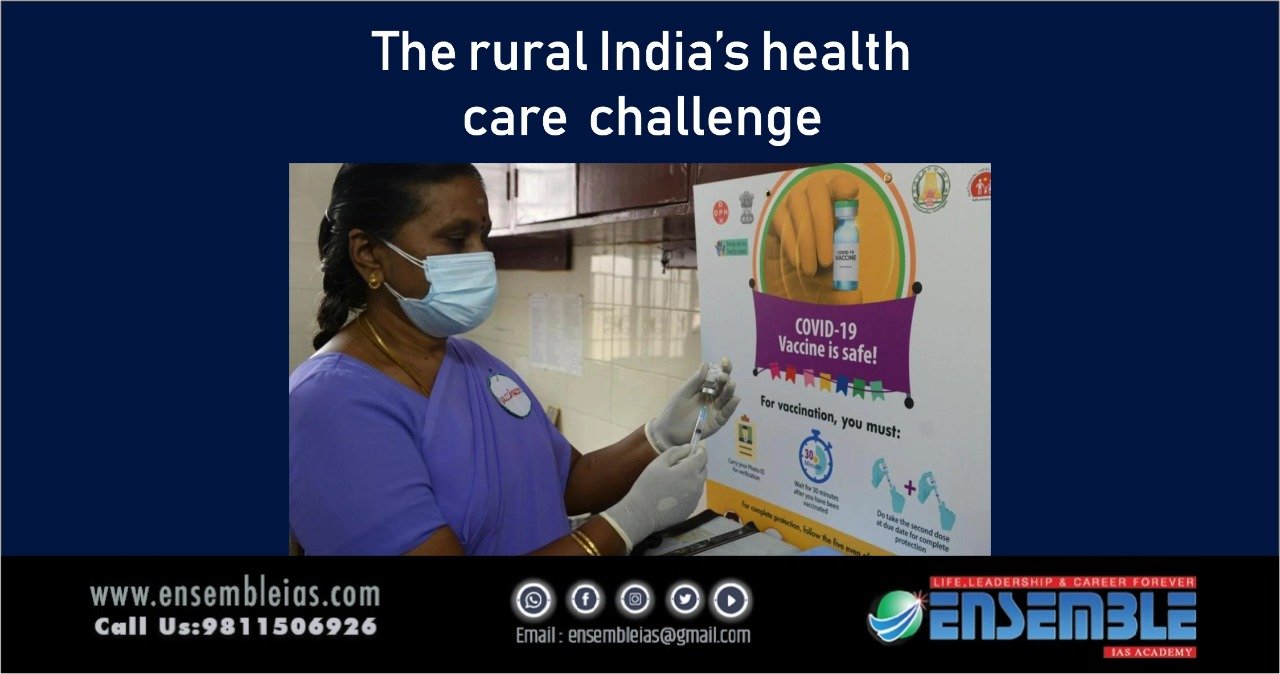The rural India’s healthcare challenge
The rural India’s healthcare challenge: Managing Covid requires a revamp of rural curative care infrastructure, and reorientation of health personnel competencies and public expectations
To buy our online courses: Click Here
Covid-19 made inroads into rural and peri-urban areas during the second wave, with rural districts accounting for 53% of new cases and 52% of Covid-19 deaths in May, according to a recent report. This could be an even bigger challenge during a subsequent surge. Set within the larger context of a poorly funded public health system, the inadequacies of rural health care are immense.
There is an 18% shortage of health subcentres (SC), 22% shortage of primary health centres (PHC), and a 30% shortage of community health centres (CHC) in rural India (2018), with just 3.2 government hospital beds for every 10,000 people.
In mid-May, the government released the SOP on Covid-19 containment & management in peri-urban, rural & tribal areas. It lays down a comprehensive range of measures including surveillance, screening, isolation, referral; home and community-based isolation and monitoring; a three-tier structure for institutional Covid-19 management; post-Covid-19 management; mental health support; vaccination; and intersectoral coordination, community mobilisation and behavioural change, led by gram panchayats and community-based structures. While commendable in its approach, its implementation will be met with gargantuan challenges.
It is important to understand the development philosophy that characterises India’s rural health system. Traditionally, rural health care in India has seen a prominent curative-preventive dichotomy. In contrast to urban areas, preventive care services, including maternal and child health services, family planning, and immunisation, have dominated rural health allocations, and curative care has been inadequate.
Rural health services constituted only 27% of state public expenditure on “medical and public health” in 2015-16, while urban health services constitute 44%.
Combating rural Covid-19 will not only entail a revamp of rural curative care infrastructure and manpower, but will also require a reorientation of health personnel competencies and public expectations from the rural health system.
As of 2019, only 59.2% of SCs and 55.9% CHCs had auxiliary nurse midwife (ANM) and specialists’ quarters respectively, and 11.5% SCs lacked all-weather approachable roads. As of 2020, 34.2% PHCs functioned 24×7, while CHCs saw a 76.1% shortage of specialists, with only 51.7% CHCs having a functional X-ray machine.
Similarly, many district hospitals, which act as dedicated Covid-19 hospitals for severe cases, remain highly deficient in critical care infrastructure. While schools and community halls can be converted into makeshift Covid care centres, a lot would depend on how we empower ANMs and multi-purpose workers as nodal persons at these centres.
Turning a four-six bed PHC into a 30-bed dedicated Covid-19 health care centre (DCHC), with the provision of oxygen, drugs, and manpower, will be a mammoth task. Also, retraining medical officers and nurses would be pivotal since, in most cases, their clinical armamentarium remains largely restricted to simple ailments and maternal and child health care.
It is unrealistic to expect that such extensive curative care gaps could be filled even temporarily within a short span, which makes it even more important to focus on preventive efforts (including vaccination), with double the usual strength for rural areas. The SOP has provisions for risk communication and community mobilisation measures and envisages a prominent role for village health nutrition and sanitation committees (VHNSC) and gram panchayats. However, this has to be backed with sufficient finances, technical assistance, and local autonomy. Addressing the maldistribution of Covid facilities between rural and urban areas is essential.
During the first wave, many grassroots- and middle-tier public health facilities catered to essential non-Covid-19 health care requirements. Even a cursory examination of publicly available data reveals that such routine essential services suffered considerable disruption. With most rural health facilities involved single-mindedly in Covid-19 mitigation, the impact on routine essential care could get worse and can be disastrous unless adequate provisions are made. Haphazard management of other common febrile conditions in the Covid-19 scenario has been common.
Interactions with grassroots health personnel reveal that even with a lesser caseload, segregation of patients in outpatient departments has been challenging. Further, while ancillary staff are recruited to assist in a range of activities from case monitoring to surveillance, the burden of training and preparing them often falls on overburdened health personnel. It will be crucial to address these in a rural flare-up of the pandemic.
One important measure to facilitate surveillance, early detection, monitoring, as well as community participation in remote areas could be to involve the ubiquitous informal practitioners (IP) through appropriate crash training. The West Bengal government recently announced such a measure. While this could be contested by the medical fraternity, an emergency of this magnitude warrants extraordinary steps as the benefits exceed the risks. It has been shown that apart from convenience and affordability, cultural factors are an important reason for visiting IPs as they often have the faith of their communities. The SOP already envisages involving religious leaders to facilitate Covid-appropriate behaviour.
Also Read: What puts lions and tigers at coronavirus risk?
The most favourable and enduring transformations are often forged in the crucible of severe challenges. While the rural challenge looks insurmountable, successful implementation could provide scaffolding for an exemplary rural health system that India has dreamt of ever since independence.




